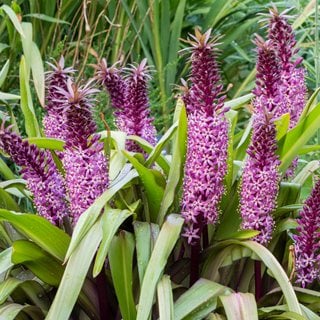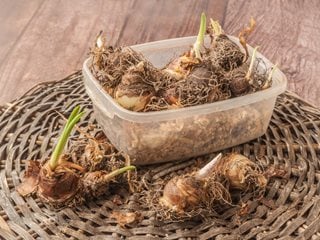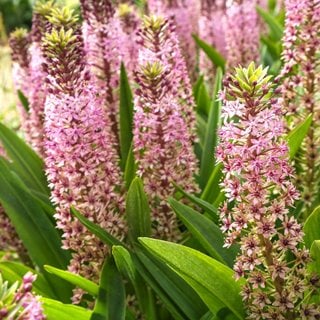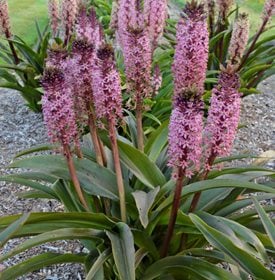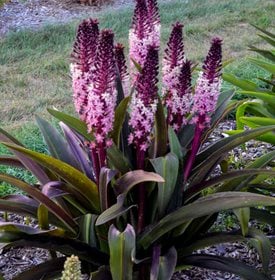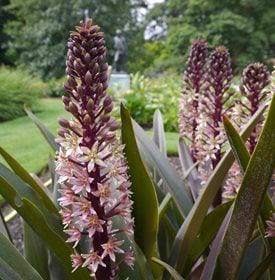How to Grow Pineapple Lily (Eucomis)
Learn all about planting and caring for this exotic summer-blooming bulb.Pineapple lily (Eucomis) is neither a true lily nor related to the tropical fruit, yet it’s easy to see how it earned its common name. Boasting eye-catching flowers that resemble miniature pineapples, this South African native is often used to bring tropical flair to garden beds and containers. In midsummer, it sends up tall spires of tiny star-shaped blooms crowned by spiky tufts of pineapple-like bracts. In addition to its striking flowers, pineapple lily also has attractive arching foliage, making it a showstopper even when not in bloom.
Despite their exotic appearance, pineapple lilies are incredibly easy to grow and some are winter hardy to zone 6. In colder climates, you can enjoy them as annuals or store the bulbs indoors during the winter months for replanting the following spring.
On this page: Basics | Growing Tips | Care and Maintenance | Pictures | Frequently Asked Questions
On this page:
- BASICS
- GROWING PINEAPPLE LILIES
- PINEAPPLE LILY CARE AND MAINTENANCE
- PINEAPPLE LILY VARIETIES
- FREQUENTLY ASKED QUESTIONS
BASICS
Botanical name:
Eucomis spp. and hybrids
Common names:
Pineapple lily, pineapple flower, king’s flower
Zones:
7-10, with some hardy to zone 6
Exposure:
Full sun to partial shade
Bloom time:
Mid to late summer, with the blooms lasting for 6 to 8 weeks
Height/spread:
1 to 3 feet tall and 2 to 4 feet wide, depending on the variety
Flowers:
May be purple, pink, yellow, or white, with some varieties having bicolored blooms. The star-shaped florets open from the bottom of the bloom spike upward over a period of several weeks.
Foliage:
Broad, strappy leaves with wavy edges form an attractive funnel-shaped rosette. Colors range from deep green to shades of purple and burgundy.
Uses:
Mixed borders, alone or as a thriller in container plantings, tropical-themed gardens, rock gardens, or cut flower gardens.
Special attributes:
- Long-lasting cut flower
- Attracts butterflies, hummingbirds, and other pollinating insects
- Deer and rabbit resistant
- Not considered to be toxic to people or pets
HOW TO PLANT PINEAPPLE LILY
When to plant:
In spring after all danger of frost has passed and the soil temperature has warmed to at least 65 degrees F. You can also plant the bulbs in pots indoors about a month before it’s warm enough to move them outdoors in late spring.
Where to plant:
For optimal flowering, plant in a spot that receives full sun (at last 6 hours daily). In southern gardens, where the sun is more intense, a spot that receives some afternoon shade can help prevent scorching of the leaves.
Soil requirements:
The ideal soil for pineapple lilies is rich, porous and drains well, yet still retains enough moisture for the plant’s roots. If your soil is heavy or compacted, amend it with compost or other organic matter to help improve drainage.
Planting in the garden:
You can buy eucomis plants as dormant bulbs or as potted nursery starts in the spring. However, the latter are often easier to find and will give you a head start on planting.
If growing from bulbs, plant the bulbs root side down in a hole 6 inches deep, spacing them 10 to 12 inches apart. Cover with soil and water lightly, keeping the soil evenly moist until the bulbs sprout.
If growing from nursery starts, dig a hole about twice as wide and the same depth as the root ball and mix in any amendments, as needed. Place the plant in the hole so the crown is level with the surrounding soil and then backfill. Tamp down the soil gently to remove air pockets, and water thoroughly.
Growing in containers:
In climates where pineapple lilies are not winter hardy, the easiest way to grow them is in a container you can move into a protected location during the winter months. If growing from bulbs, plant them to a depth of 3 to 4 inches in a well-draining soilless potting mix. Generally, three bulbs will nicely fill out a 12-inch-diameter container. Make sure the pot you choose has plenty of drainage holes in the bottom to prevent soggy soil.
Propagation:
By seed or by removing bulb offsets from established plants in the spring. (*See note below on propagating patented plants. Check your plant tags for ® or ™ symbols next to the plant name.)
PINEAPPLE LILY CARE
Watering:
In spring and summer, when plants are actively growing, water to keep the soil evenly moist but not waterlogged, providing about an inch of water per week. Container-grown plants may need more frequent watering. In fall, after plants have finished blooming, water more sparingly. Pineapple lilies need dry conditions when they are dormant to prevent rot and maintain bulb health.
Fertilizing:
To keep your pineapple lilies lush and blooming vigorously, feed them with a balanced, water-soluble fertilizer in the spring as soon as you see new growth emerge, and then reapply monthly until the growing season ends in early fall. Withhold fertilizing during the winter months.
Pruning:
: Pineapple lilies need no pruning, other than to remove dead or damaged foliage. After blooming has finished for the season, leave the foliage intact and let it die back naturally. The leaves will continue to gather energy from the sun to be stored in the bulb for next year's flowers. You can remove the dry foliage once it turns yellow and wilts to the ground in the fall.
Pests and problems:
Pineapple lily is not susceptible to serious pest or disease problems, but watch out for snails and slugs, especially on tender young foliage.
PINEAPPLE LILY VARIETIES
FREQUENTLY ASKED QUESTIONS
What do you do with pineapple lily after flowering?
It’s fine to leave the spent flowers in place, unless you find them unattractive. The blossoms are replaced by shiny seed capsules that add ornamental interest to the garden while providing a food source for birds.
Are pineapple lilies hardy?
Most Eucomis are hardy to zone 7 and possibly lower if you cover your plants with a thick layer of mulch in the winter to help insulate them from extreme cold. Container-grown plants should be moved to a protected location or indoors, ideally to a spot where temperatures stay cool but don’t drop below 40 degrees F.
Do pineapple lilies come back every year?
Pineapple lilies are perennials, meaning they will bloom year after year when grown in favorable conditions. In climates where they aren’t winter hardy, you can grow them as annuals or preserve the bulbs for replanting the following spring by digging them up in the fall and storing them indoors in a cool, dry place. (Learn more about the after-care and digging up of bulbs.)
Do pineapple lilies like sun or shade?
Pineapple lilies grow well in full sun or partial shade, but they may produce fewer flowers if grown in a shadier location. If your pineapple lilies aren’t blooming, it could be due to insufficient sunlight.
Are pineapple lily flowers fragrant?
Some species of pineapple lily emit a distinct odor that is sometimes likened to the smell of boiled potatoes, a strategy the plant uses to attract pollinators -- particularly flies. Fortunately, not all pineapple lilies smell the same. The scent of many cultivars is less pronounced, making them perfectly suitable for use as cut flowers.
*REGARDING PROPAGATION: When it comes to propagating patented plants, there are strict rules in place prohibiting reproduction or propagation of these plants in any way. This means you can't reproduce them (even for use in your own garden), sell them, or bring them into the country without permission. The law does not make exceptions for what some might consider minor infringements. Any unauthorized use of patented plants is considered an infringement.
RELATED:
The Best Summer Bulbs to Grow
Top 20 Spring-Blooming Bulbs
